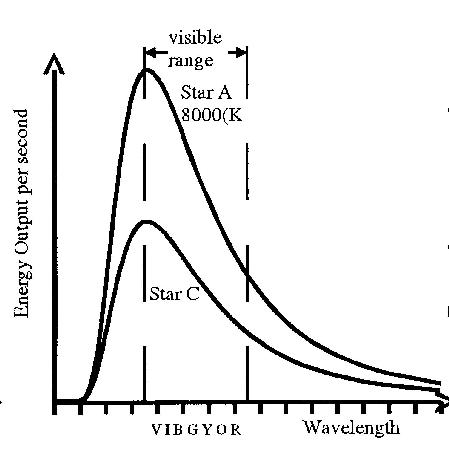Determining Properties of Stars
(20 points) In each of the following cases, explain whether we can determine the stated property of a star simply by analyzing its spectrum. If so, how?- temperature
We can determine the temperature of a star in multiple ways by analyzing its spectrum. Since the spectrum of a star is approximately a blackbody we could measure its temperature by looking at the wavelength at which it is brightest or by measuring its color (bluer is hotter). We could also look at the strength of spectral lines in the atmosphere of the star. Most spectral lines are strong at a specific temperature. For example, the hydrogen lines are strongest at about 10,000 K, and disappear rapidly at higher temperatures as the hydrogen is ionized.
- radial velocity
We can detemine the radial velocity (speed toward or away from us) of a star by measuring the Doppler shift of lines in its spectrum. If a line is shifted toward the blue, the star is coming towards up. If it is shifted to the red, the star is moving away from us.
- radius
This is a tricky one. For a given temperature, the larger a star is, the more energy it puts out, so a larger star appears brighter. But distance also plays a role. A closer star also appears brighter. So you need more information than just the spectrum, you also need the distance
- mass
A spectrum is changed in subtle ways by the mass of the star. Stronger surface gravity makes absorption lines broader, but that doesn't tell you the mass unless you know the radius. The only way to get a direct measurement of the mass is from radial velocity measurements of the shift in spectral lines in a binary star system. But this can only be done for binary stars, so I would say the answer to this question is also "no".
(Blackbody Radiation (20 points)
Use the Figure below to answer the following questions. Wavelength increases towards the right. Explain your answers!
- Which light curve has a lower surface temperature (A, C, or same temp)
How can you tell?
The stars are the same temperature. You can tell because their spectra both peak at the same wavelength
- Which light curve has greater energy output (A, C, or same) and why?
Star A has greater energy output, because its curve is higher than that of Star C.
Spectral Lines (20 points)
What two pieces of information can be gained from observing spectral lines in a star? Are there any other means of getting this information?Spectral lines in a star can tell you about the temperature and the composition of a star. You get the temperature because individual lines only appear in specific temperature ranges. You get the composition, because each element has specific spectral lines that can be identified in the spectrum of a star. The shape of the spectrum (i.e. the color) can also be used to tell you the temperature of the star.
Formation of the Solar System (20 points)
How does the Solar Nebula theory of planetary formation explain the planets orbiting in the same plane and the same direction. If you found a solar system with planets orbiting in random directions, would the nebular theory be a good explanation for how it formed? Can you think of any theory that would explain random orbits?The nebular theory would not be a good explanation for the formation of a solar system with random orbital directions. In the nebular theory, the nebula from which a solar system forms collapses to a disk in which the planets are formed. This results in all the planets orbiting in the same plane and in the same direction. For an explanation of random orbits, I will accept just about any reasonable answer. The purpose of this question is to get you to come up with a hypothesis on your own. Examples that I can think of are: disruption of the planetary orbits after the planets formed, capture of planets from interstellar space and collision, or near collision of solar systems in the process of forming. There are others...
Planetary surfaces (20 points)
What processes shape the appearance of the surfaces of the terrestrial planets? Name at least two properties of the Earth that make its surface significantly different from those of the other terrestrial planets.The surfaces of the terrestrial planets are shaped by volcanism, impacts, plate tectonics, and erosion. Earth is different in two primary ways. Plate tectonics seems to require the presence of water, so it only occurs on Earth. The earth is also the only terrestrial planet covered with a significant amount of liquid. The presence of water, and the energy it transports in the form of the water cycle, greatly increases the rate of erosion on Earth.